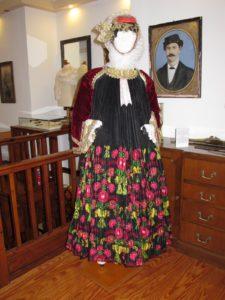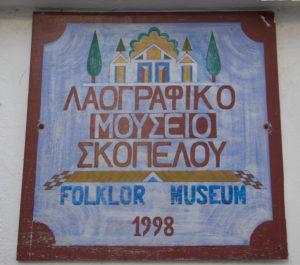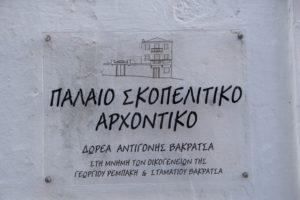On the long journey back to the history and tradition of Skopelos, its museums are important cradles of culture.
Museum sites, mansions and traditional houses unlock different aspects and eras of the rich past of Skopelos.
The city of Skopelos (Chora) was declared Traditional Settlement of Extraordinary Beauty in 1978 by Presidential Decree (19/10/78 presidential decree 594, 13-11 / 78) due to its architectural heritage. For this reason, there are strict structural principles and restrictions for all buildings within the settlement. In this article, we present some of the island’s most characteristic monuments that outline the great tradition of the island.
The Folklore Museum of Skopelos Town
The Folklore Museum of Skopelos Town is housed in an old mansion that was built in 1795 and reconstructed in 1971, after being designated a listed building. In 1991 it was donated to the Municipality of Skopelos by the Nikolaidis family and, thus, in August 1992, the Folklore Museum inaugurated its operation, reviving the old mansion.
The collections of the Folklore Museum of Skopelos include a series of icons, embroidery, paintings, ceramics, black and white photographs, traditional costumes, tools, wood-carved furniture, etc. Most of the exhibits are donations by the residents of Skopelos and the Nikolaidis family. With great emotion, many grandmothers opened their family chests and generously offered all that treasure.
Today, the Folklore Museum often organizes events and various educational programs. It is well worth to pay a visit to this place and admire its unique collections. It is located very close to the OTE building. Please get informed by your hotel reception about the opening hours.
The Folklore Museum of Skopelos Glossa
In the center of the famous, historical and beautiful village of Glossa, there is also a Folklore Museum, the Folklore Museum of Skopelos Glossa. It is located above the church of the Assumption of the Virgin Mary.
This is a two-story traditional house, in which the visitor will have the opportunity to see the traditional costumes of the island and everyday household items. Also, you are given the opportunity to be informed about the interior design and artifacts that decorated the typical traditional houses of the village. During the summer months, the Folklore Museum of Glossa is open in the morning and in the afternoon, but it would be helpful to confirm this with your hotel reception.
Vakratsa Mansion
Another characteristic mansion of the island is the Vakratsa mansion. It is a three-story building that fully depicts the era of the 18th century. It is located in the center of Skopelos Town, just above the beach. Mrs. Antigoni Vakratsa was a doctor and owner of the mansion. She donated it to the Municipality of Skopelos to make it a Museum.
The Vakratsa Mansion exhibits a collection of various personal items and remarkable relics that belonged to the family. The room where Dr. Stamatis Vakratsas, Antigone’s father, operated as a doctor, remains untouched along with his medical tools. In addition, visitors have the opportunity to see the interior of a typical Skopelos’ mansion. Finally, it is worth noting that many cultural events are organized in the beautiful courtyard, with the characteristic palm tree, such as book presentations and speeches. Vakratsa Mansion is open daily, but it would be helpful to confirm this with your hotel reception.
The House of Pavlos Nirvanas
One of the most important contemporary monuments in Magnesia is the House of Pavlos Nirvanas. The acclaimed modern Greek author lived there during his childhood and today it houses the History Museum of Skopelos. Skopelos was the birthplace of Pavlos Nirvanas and his real name was Petros Apostolidis.
The building lies in the center of the traditional settlement of Skopelos Town, in the district of Agios Ioannis. It is located next to the church of the Three Hierarchs, overlooking amphitheatrically the town and the picturesque port of Skopelos Chora. It is a stone-built two-story building. The facade is characterized by a closed covered balcony, which is the dominant architectural element. Today the house hosts the exhibition Paparithos Skopelos. This exhibition is a timeline of the town’s history from antiquity to the present day.
The house is one of the most remarkable and representative examples of local architecture. It is of Macedonian style, without subsequent alterations and was built in the first half of the 19th century. For these reasons, in 1965 it was designated by the Ministry of Culture as a Historic Preserved Monument of Architectural Heritage.
The representation of the past contributes to the preservation of the unique cultural identity of Skopelos. Will you miss the opportunity for a time travel?





